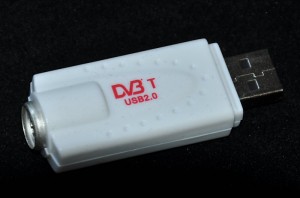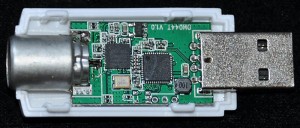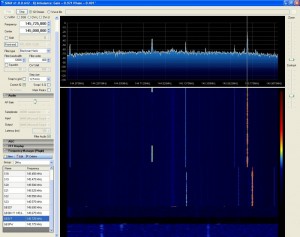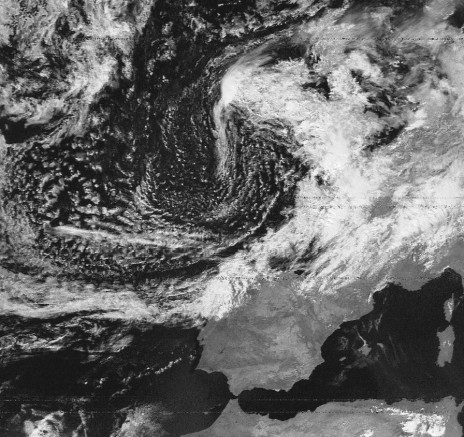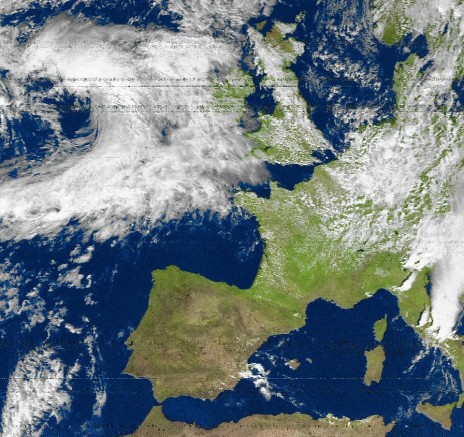Software Defined Radio
Or... the most amazing development in radio I think I've ever seen.
As I have said elsewhere on this site, I was badgered back in to the hobby by some of those who are close to me and the RTL SDR Dongle was the straw that broke the camel's back.
The conversation went something like this...
MK - "Have you seen these SDR's?"
Me - "What's an SDR?"
MK - "Software defined radio. There is a really, really cheap one that covers from around 70Mhz up to 1.5Ghz. You should get one!"
Me - "No thanks, not for me; I like a tuning dial I can stick my finger in. Who wants to QSY with a mouse?"
MK - "Well I'm getting one; I'll let you know how it goes."
Some weeks later, the said gadget arrived and a demo was duly arranged. "Thanks a lot MK!"... Just when I really don't have the time to take up a hobby, you go and get me all fired up!
Long story short, my SDR Dongle arrived a couple of weeks later and it's been a total revelation. For the last 20 years, I've been walking in to the office and switching on BBC Radio 4. Not any more, I can't remember the last time I listened to "Gardener's Question Time" and "Woman's Hour" is a distant memory. Actually, I lie. The SDR covers the FM Broadcast Band better than any other radio I have in the house so I'm still doubled up with laughter during "I'm Sorry I Haven't a Clue" and "Just a Minute".
The Hardware...
The "Radio" actually started out life as a U.S.B. D.V.B. (Digital Video Broadcast) dongle, designed to allow you to receive and watch D.T.V. (Freeview in the U.K.) on your Laptop or P.C. It's based on the RTL2832U chip hense the name RTL SDR.
Some really clever guy figured out that the device could be configured to output the raw data packets on to the U.S.B. and, once there, they could be manipulated in some really interesting ways including F.M., A.M. and U.S.B. demodulation.
It also turned out that the receiver could be tuned across a massively wide frequency range and with clever software, you effectively end up with a multimode communications receiver covering V.H.F, U.H.F and beyond.
They come from many sources and under many different brand names but mine was from that popular on-line auction site for the princely sum of just £12.00 including postage. If you are tempted, check the specifications before you buy, you are looking for the RTL2832U in combination with the Elonics E4000 tuner.
According to Osmocom, the guys who originally discovered what was possible, the RTL2832U/E4000 combination has the highest sample rate of 2.8MS/s and a tuning range from 64MHz all the way up to 1.7GHz.
Take a look at the RTL2832U/E4000 Compatibility List.
The Software...
As impressive as the hardware is, the real heart of the system is the software that drives it. There are a number of different programs available, many are Open Source and are readily downloadable for free.
My current favourite is SDR# (pronounced SDR Sharp). Youseff is continually developing the application so it's worth keeping the software up to date as new features and functions are being included all the time.
As of writing, SDR# gives you Wideband F.M, Narrowband FM, AM, USB, LSB, DBS, CW-L and CW-U.
All of this is running under M$ Windows but, if you are a Linux user, then GNU Radio gives you a whole lot more, including many digital modes such as PSK and others.
So... What does it do exactly?
For those of us more familiar with "traditional" receivers, you can think of the SDR as a "Scanner" or "General Coverage Receiver" in your P.C. It is supposed to cover anything from 64MHz to 1.7GHz but the development community are pushing these limits all the time and I'm now reading about people getting the things up to 3GHz and above. Interestingly, there are also projects going down to H.F and below.
As for the available modes, the software, in VERY basic terms, performs complex mathematical transforms on the data to decode or demodulate whatever you are tuned to. In the case of Linux, the GNU Radio project allows you to "plug in" any number of demodulators and decoders for just about any type of transmission you care to mention. For those of us on M$ Windows, you have to be a little more creative.
The Amateur Bands
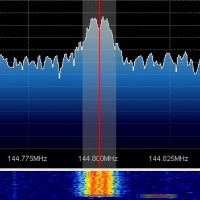
In the full screen shot above, the centre frequency is 145.500MHz but the software is set to sample just over 2MHz of bandwidth. Therefore, what you see on the spectrum display is the whole of 2Mtrs in one go! You can see 144.800 Packet, slightly left of centre, and GB3VT, our local VHF Repeater on 145.725MHz towards the right. If you look, you can even see the input to VT on 145.125MHz. For me, that's just staggering. I can't say what the cost of that facility would have been just a few years ago but today, it's less than the cost of round at the pub. 2Mtrs and 70cms are very good here... while 4Mtrs and 23cms are both covered by the dongle, I've no idea how it performs there yet...
As of writing, there is no actual "Scan" function in SDR# but it can only be a matter of time. The most recent addition has been the Frequency Manager. This takes away the need for all the Post-It notes stuck to the shack walls and lets you store frequency, mode and bandwidth ready for clicking the next time you want to tune in.
FM Broadcast Band
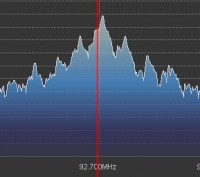
FM Broadcast is now in glorious Wideband FM Stereo with RDS.
The SDR is so good that I rarely bother to listen to F.M. broadcast on any other device with the exception of when I'm using the SDR for something else.
RDS is new to SDR# and shows just how rapidly this software is being developed. By the time you read this I'm willing to bet that even more features and functions have been added. There is talk of signal meters, audio recording, auto tuning and all manner of other goodies.
137MHz NOAA Polar Orbiting Weather Satellites
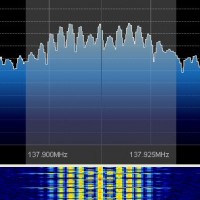
Back in the day this was a mode that I tried to get involved in. Anything in space has always fascinated me and the ability to receive live images of the Earth's surface, transmitted directly from orbit, was like science fiction.
The SDR Dongle is far from an ideal receiver due to it's wide open front-end, and total lack of filtering but, and it's a bit but, it does actually work. Not only does it work but it produces excellent results when you consider what the alternative would cost. It also has the ability to deliver the full 37KHz bandwidth you need for APT satellites.
Again, you have a choice of software, much of it free or Open Source, and I'm currently using the very popular WxToImg package. This software not only gives you accurate satellite pass predictions but it does a really good job of decoding the images and, it lets you apply some quite sophisticated filters, including Multispectral Anaylsys giving the false colour image you can see below.
So far, I've only used a 2Mtrs Vertical antenna for the NOAA satellites but I've found it works OK to a degree. Due to some very odd U.K. band planning the 137MHz Space Band gets hit hard from local Pager Towers but the powers that be don't seem too interested.
We, the old man and I, are currently in the throws of building a proper aerial for the job; a QFH or Quadrifila Helix Antenna. Not only will this give us Right-hand Circular Polarization which will improve the signal strength, but it's radiation pattern will help filter the pager noise on the horizon.
Watch out for the QFH Page coming soon.
Conclusion
So, there you have it. For the sake of the cost of a Fish Supper for two, you can get your hands on a really capable bit of kit that works well and opens up all sorts of possibilities. I've not mentioned Airband, PMR, Local Taxis or any of the other services that this little gem will pick up but then you can put that together for yourself.
It's not the best receiver in the world, it not the most sensitive (though I'm staggered at just what it does pull in), it's not the most selective and it certainly not the most sophisticated. But it is the cheapest... probably.
Update
As predicted, the current version of SDR Sharp now has a recording function, frequency manager for storing anything interesting in memory and specific functionality updates for the RTL version of the dongle. One very nice touch is that the software now remembers what you were doing so comes up just as you left it last time. Previous versions were a bit odd as you had to select the input device and, in my case, set the sample rate before getting started. Well done Youssef!
Another Update - 29th August 2014
A couple of months back I decided to resurrect the SDR Dongle. It's been in the draw for a few months while other things took preference. Now I'm happily installed in the new shack, and having replaced a PC that had been used to drive the dongle, I thought it was time to get a few more NOAA images.
All went well for a couple of weeks then we had a small electrical storm. The dongle wasn't connected to the PC via the USB cable but it was connected to the antenna... You can probably guess the rest.
So, for the time being, no more SDR Dongle for me to play with. However, the experience was great and I'll certainly be looking for an SDR replacement in the near future, possibly something a little more substantial than an DTV Dongle!

